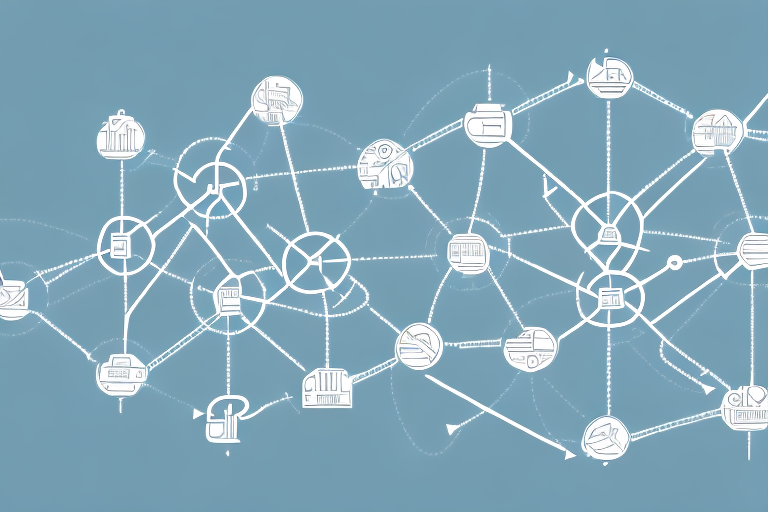The Evolution of Logistics: From 1PL to 4PL
The logistics industry has undergone significant transformations over the years, evolving from simple models to more complex and integrated systems. Understanding this evolution is crucial to grasping the concept of Fourth-Party Logistics (4PL).
1PL - First-Party Logistics
First-Party Logistics (1PL) is the most basic form of logistics management. In this model, the manufacturer or the producer is solely responsible for handling the logistics activities, including transportation and delivery of products to customers. This model is straightforward but limited in scope, as it does not leverage external expertise or resources.
2PL - Second-Party Logistics
Second-Party Logistics (2PL) introduces the use of external transportation providers. Companies outsource the transportation of goods to specialized carriers, such as trucking or shipping companies. This allows manufacturers to focus more on production while improving transportation efficiency.
3PL - Third-Party Logistics
Third-Party Logistics (3PL) represents a more integrated approach, where logistics providers offer comprehensive supply chain management services. These services include transportation, warehousing, and distribution. 3PL providers enable companies to outsource multiple logistics functions, enhancing overall supply chain efficiency.
4PL - Fourth-Party Logistics
Fourth-Party Logistics (4PL) takes the outsourcing model a step further by managing the entire supply chain process. A 4PL provider acts as a single point of contact, coordinating various 3PL providers and other logistics services to deliver a seamless and optimized supply chain solution. This model emphasizes strategic partnership and integration, allowing companies to focus on their core competencies.
How 4PL Differs from Other Logistics Models
While each logistics model offers distinct advantages, 4PL stands out due to its comprehensive and integrative approach. Here are the key differences:
- Scope of Services: Unlike 3PL providers that focus on specific logistics functions, 4PL providers oversee the entire supply chain, including planning, execution, and optimization.
- Strategic Partnership: 4PL providers act as strategic partners, collaborating closely with clients to align logistics strategies with business objectives.
- Technology Integration: 4PL solutions often involve advanced technology platforms that offer real-time visibility and data analytics across the supply chain.
- Single Point of Contact: Companies deal with a single 4PL provider, simplifying communication and coordination compared to managing multiple 3PL vendors.
For a deeper understanding of logistics models, refer to the Supply Chain Quarterly's guide on 4PL.
Benefits of Implementing a 4PL Strategy
Adopting a 4PL approach offers numerous advantages that can significantly impact a company's efficiency and profitability:
- Enhanced Efficiency: By streamlining logistics operations through a single provider, companies can eliminate redundancies and optimize processes.
- Cost Savings: 4PL providers leverage their expertise and volume to negotiate better rates with carriers and suppliers, leading to reduced logistics costs.
- Improved Visibility: Advanced tracking and monitoring systems provide real-time insights into the supply chain, enabling better decision-making.
- Focus on Core Competencies: Outsourcing logistics allows companies to concentrate on their primary business activities, fostering growth and innovation.
- Scalability: 4PL solutions can easily scale with a company's growth, accommodating increased volumes and expanding into new markets.
- Risk Management: 4PL providers ensure compliance with regulations and manage risks associated with transportation and distribution.
According to a report by Gartner, companies that adopt 4PL strategies experience up to a 20% increase in supply chain efficiency.
Key Players in the 4PL Industry and Their Roles
The 4PL ecosystem comprises various stakeholders, each playing a vital role in the seamless functioning of logistics operations:
4PL Providers
4PL providers serve as the central hub, managing and coordinating all logistics activities. They oversee the entire supply chain, integrating various services such as transportation, warehousing, and IT solutions to deliver a unified logistics strategy.
Technology Providers
These companies offer the digital platforms and tools essential for managing and analyzing logistics data. Solutions like Transportation Management Systems (TMS) and Warehouse Management Systems (WMS) are crucial for efficient operations.
Consulting Firms
Consultants provide strategic guidance to companies looking to implement 4PL solutions. They assess current logistics processes, recommend improvements, and assist in the transition to a 4PL model.
Customers
Clients are the businesses that hire 4PL providers to manage their logistics operations. They collaborate closely with 4PL providers to ensure that logistics strategies align with their overall business goals.
Regulatory Bodies
These organizations establish and enforce regulations related to logistics, such as safety standards and environmental guidelines. 4PL providers must adhere to these regulations to ensure compliant and ethical operations.
Technology Behind 4PL Solutions
Technology is the backbone of effective 4PL solutions, enabling real-time data exchange, automation, and enhanced decision-making. Key technological components include:
Transportation Management Systems (TMS)
TMS platforms facilitate the planning, execution, and optimization of transportation operations. They help 4PL providers manage shipments, select carriers, and track deliveries in real-time.
Warehouse Management Systems (WMS)
WMS solutions oversee all aspects of warehouse operations, including inventory management, order processing, and storage optimization. They ensure efficient handling and accurate tracking of goods.
Enterprise Resource Planning (ERP) Software
ERP systems integrate various business processes, providing a centralized platform for managing finances, procurement, and supply chain activities. This integration enhances coordination and data visibility across the organization.
Data Analytics and Artificial Intelligence
Advanced analytics and AI algorithms analyze vast amounts of data to identify patterns, predict demand, and optimize supply chain strategies. This leads to more informed decision-making and improved operational efficiency.
Internet of Things (IoT)
IoT devices, such as sensors and GPS trackers, provide real-time data on shipment conditions and locations. This information enhances visibility and allows for proactive management of logistics activities.
For more insights on logistics technology, visit the McKinsey & Company report on supply chain management.
Challenges and Solutions in Implementing a 4PL Model
While the benefits of a 4PL strategy are substantial, companies may encounter several challenges during implementation:
Resistance to Change
Internal stakeholders may resist outsourcing logistics functions due to concerns over loss of control or job displacement. Solution: Effective change management, including clear communication of benefits and involving stakeholders in the transition process, can mitigate resistance.
Selecting the Right 4PL Provider
Choosing a provider with the necessary expertise and alignment with business goals is critical. Solution: Conduct thorough evaluations, including due diligence on the provider's track record, technology capabilities, and client testimonials.
Integration of Systems
Seamless integration of IT systems between the company and the 4PL provider is essential for data accuracy and operational efficiency. Solution: Invest in robust IT infrastructure and ensure compatibility of software platforms before implementation.
Cost of Implementation
Initial investments in technology and process restructuring can be substantial. Solution: Develop a clear ROI projection and consider phased implementation to manage costs effectively.
Maintaining Service Quality
Ensuring that the 4PL provider meets service standards consistently is crucial for customer satisfaction. Solution: Establish clear performance metrics and regular monitoring to maintain high service quality.
Future Trends and Innovations in the 4PL Industry
The 4PL industry is continually evolving, driven by technological advancements and changing market demands. Key future trends include:
Increased Use of Artificial Intelligence
AI will play a pivotal role in predictive analytics, demand forecasting, and autonomous decision-making, enhancing the efficiency and responsiveness of supply chains.
Sustainability and Green Logistics
There is a growing emphasis on sustainable logistics practices, including the adoption of eco-friendly transportation modes and the optimization of routes to reduce carbon emissions.
Blockchain Technology
Blockchain offers enhanced transparency and security in supply chain transactions, enabling secure and immutable tracking of goods from origin to destination.
Omnichannel Logistics
The rise of e-commerce has increased the demand for omnichannel logistics solutions that integrate online and offline sales channels, ensuring seamless order fulfillment and delivery.
Robotic Process Automation (RPA)
RPA can automate repetitive tasks such as data entry and order processing, reducing errors and freeing up human resources for more strategic tasks.
Collaborative Supply Chains
Enhanced collaboration between different supply chain partners will lead to more integrated and efficient logistics operations, fostering innovation and resilience.
For more on future logistics trends, refer to the Forbes article on logistics trends.
Choosing the Right 4PL Provider for Your Business Needs
Selecting an appropriate 4PL provider is vital for the success of your logistics strategy. Here are key factors to consider:
Industry Expertise
Ensure that the 4PL provider has experience in your specific industry, as this knowledge can enhance operational efficiency and address unique challenges.
Technology Capabilities
Evaluate the provider's technology stack, including their use of TMS, WMS, ERP systems, and data analytics tools. Advanced technology solutions are essential for real-time visibility and data-driven decision-making.
Reputation and Track Record
Research the provider's history, client testimonials, and case studies to assess their reliability and success in managing complex logistics operations.
Scalability and Flexibility
Your business needs may evolve over time. Choose a 4PL provider that can scale its services and adapt to changing requirements without compromising on quality.
Cost and Value
While cost is a significant factor, focus on the overall value the provider offers, including efficiency gains, cost savings, and strategic benefits.
Communication and Collaboration
Effective communication is crucial for a successful partnership. Ensure that the provider has robust communication channels and a collaborative approach to problem-solving.
Compliance and Risk Management
Verify that the 4PL provider adheres to industry regulations and has effective risk management strategies in place to handle disruptions and ensure compliance.
For guidelines on selecting logistics partners, refer to the Inbound Logistics guide on choosing logistics partners.
Implementing a Successful 4PL Strategy
Successfully implementing a 4PL strategy involves several critical steps:
Assess Your Logistics Needs
Begin by evaluating your current logistics operations to identify areas for improvement. Determine which functions can be outsourced and the specific goals you aim to achieve with a 4PL partnership.
Select the Right 4PL Provider
Based on your assessment, choose a provider that aligns with your business objectives and has the capability to meet your logistics needs effectively.
Develop a Transition Plan
Create a detailed plan outlining the steps for transitioning logistics operations to the 4PL provider. This should include timelines, resource allocation, and key milestones to ensure a smooth process.
Integrate Technology Systems
Ensure seamless integration of your IT systems with those of the 4PL provider. This integration is essential for real-time data exchange and effective supply chain management.
Establish Clear Communication Channels
Set up regular meetings and reporting structures to facilitate ongoing communication between your team and the 4PL provider. Clear communication is vital for addressing issues promptly and maintaining alignment.
Monitor Performance and Make Adjustments
Continuously track key performance indicators (KPIs) to evaluate the effectiveness of the 4PL strategy. Use these insights to make necessary adjustments and optimize logistics operations.
Foster a Collaborative Partnership
Develop a strong, collaborative relationship with your 4PL provider. Mutual trust and cooperation are essential for achieving long-term success and continuous improvement.
For a comprehensive implementation guide, refer to the Supply Chain Management Review's implementation strategies.
Measuring Success: Metrics to Track When Implementing a 4PL Model
To evaluate the success of your 4PL implementation, track the following key metrics:
- On-Time Delivery Performance: Measures the percentage of shipments delivered on schedule, reflecting the efficiency of the logistics process.
- Inventory Accuracy: Assesses the precision of inventory records, indicating effective inventory management.
- Order Cycle Time: The time taken from order placement to delivery, highlighting the speed of the supply chain.
- Cost Savings: Evaluates the reduction in logistics costs achieved through the 4PL partnership.
- Customer Satisfaction: Gauges customer feedback and satisfaction levels related to delivery performance and service quality.
- Supply Chain Visibility: Measures the level of transparency and real-time tracking available across the supply chain.
- Return on Investment (ROI): Calculates the financial return achieved from the 4PL investment compared to the costs incurred.
Regularly monitoring these metrics helps in identifying areas of success and those needing improvement, ensuring the continuous optimization of your logistics strategy.
For more information on logistics metrics, visit the Logistics Management article on key supply chain metrics.
Communication and Collaboration in 4PL Implementation
Effective communication and collaboration between your company and the 4PL provider are essential for a successful implementation. Here’s how to foster a productive partnership:
Establish Clear Communication Channels
Set up dedicated communication platforms and regular meetings to facilitate ongoing dialogue. Clear channels help in promptly addressing issues and sharing updates.
Define Roles and Responsibilities
Clearly outline the roles and responsibilities of both your team and the 4PL provider. This clarity prevents overlaps and ensures accountability for specific tasks.
Set Shared Goals and Objectives
Align your business goals with the logistics strategy established by the 4PL provider. Shared objectives foster a unified approach towards achieving desired outcomes.
Implement Collaborative Tools
Utilize collaborative tools and technologies that enable seamless data sharing, real-time tracking, and joint decision-making. Tools like shared dashboards and project management software enhance collaboration.
Provide Continuous Feedback
Regularly share feedback with the 4PL provider regarding their performance and any areas requiring improvement. Constructive feedback helps in refining processes and enhancing service quality.
Encourage a Partnership Mindset
Promote a culture of mutual trust and cooperation. Viewing the relationship as a strategic partnership rather than a transactional arrangement leads to better collaboration and long-term success.
For strategies on effective communication in logistics, refer to the Harvard Business Review's guide on supply chain communication.
Conclusion
Fourth-Party Logistics (4PL) represents a sophisticated and integrated approach to supply chain management, offering extensive benefits such as enhanced efficiency, cost savings, and improved visibility. By understanding the evolution of logistics, the distinctive features of 4PL, and the roles of key industry players, businesses can make informed decisions about adopting a 4PL strategy. Implementing a successful 4PL model requires careful planning, the right technology, and a strong collaborative partnership. As the logistics industry continues to evolve, staying abreast of future trends and innovations will ensure that companies remain competitive and responsive to dynamic market demands.






















